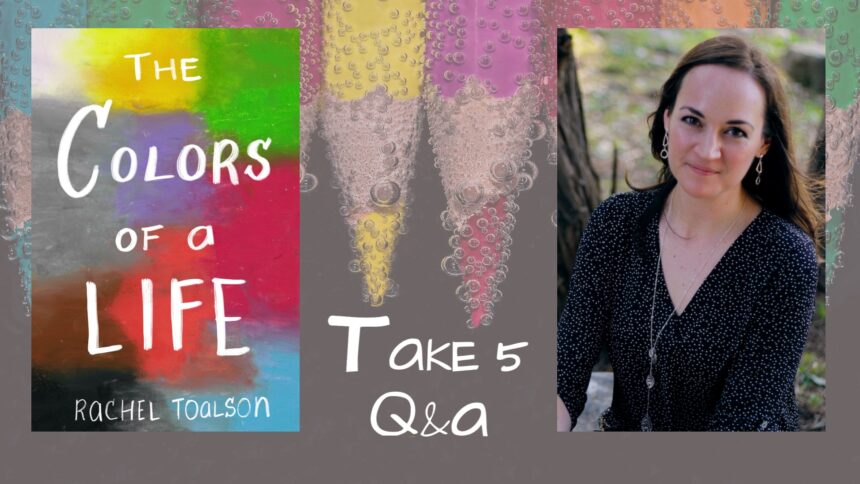Take Five Interview: Rachel Toalson and THE COLORS OF A LIFE
By Writer Unboxed | March 2, 2025 |
 We are so delighted to put the focus on WU contributor and award-winning author Rachel Toalson’s most recent book. THE COLORS OF A LIFE is a collection of poetry and is out now! What’s the pitch?
We are so delighted to put the focus on WU contributor and award-winning author Rachel Toalson’s most recent book. THE COLORS OF A LIFE is a collection of poetry and is out now! What’s the pitch?
“The Colors of a Life reminds us that all the pretty and not-so-pretty colors we experience over a lifetime shape us into who we are. And they all (even the not-so-pretty ones) add up to a brilliant life.
Perfect for fans of Mary Oliver, Sharon Olds, Billy Collins, and Maggie Smith, The Colors of a Life is Rachel’s tenth book of poetry.”
Did you catch that, WU? Her tenth! Wow. Congratulations, Rachel–you are an inspiration! Are you all as ready as we are to learn more? Here’s Rachel:
Q1: What’s the premise of your new book?
RT: The Colors of a Life is a poetry collection that observes and honors all the colors of a life. Through poetry, I explore the colors of love, loss, childhood, joy, hope, mental illness and much more, braiding the past with the present and the future. Some of the poems are humorous, some somber, some celebratory, some incredibly introspective. I span such subjects as the wonder (and comfort) of gray sweat pants, the bliss of crispy tater tots, the yellow and purple beginnings of eating disorders and body dysmorphia, the orange and red hues of connection, the brown reminders of the infinite, and all the worlds in between.
I suppose, at its heart, The Colors of a Life is a collection that celebrates life itself.
Q2: What would you like people to know about the story itself?
RT: The collection began with my hypothesis that while we don’t consider every color beautiful, they can still be beautiful. Even the colors we tend to wrinkle our noses at (brown? Who says their favorite color is brown except for my husband, because it’s the color of my eyes?) can still be beautiful when we examine them through love and understanding. So maybe there is a not-so-great memory associated with brown (hello, collecting pecans to get out of the house where a dad yelled), but how can we reframe that and look at it through a lens of understanding? How did it shape who we became, even if it was terribly uncomfortable? How can we redeem brown? Well, some of my kids’ eyes are brown. Of course that’s beautiful.
All these colors–whether we consider them beautiful or not–shape us into who we are. So maybe they’re worth paying a little closer attention to in our memories and in our present lives.
Q3: What do your characters have to overcome in this story? What challenge do you set before them?
RT: I don’t have characters, since this is a poetry book, but I think what I had to overcome and what I hope readers will overcome is a general sense of ennui and/or malaise in my life. The world can take so much out of us. But reconnecting to the beauty of moments can sometimes lift our spirits and help us feel less weary and bored and dissatisfied with where we are and where we’re going.
Q4: What unique challenges did this book pose for you, if any?
RT: Any time I’m collecting my poetry into a book, I usually have two challenges: (1) sorting through the thousands of poems I’ve written to find ones that will work well together, and (2) figuring out how to group them into sections or chapters or whatever I choose as the dividers in my book (I like dividers, because it helps underline an overall theme with the poetry collection). This collection was a little easier than most I’ve done, since I broke up the poems according to colors. It made it easier to find poems (and write new ones) and also organize them into a collection. But figuring out poem order, which poems to begin and end with, which poems to cut when things go on a little too long–those are always unique challenges to poetry collections, or at least they are for me!
Q5: What has been the most rewarding aspect of having written this book?
RT: Poetry is my space to process what’s happened in my past and what’s happening in my life today. What I appreciate most about it is that it grounds me in the present. I’m the sort of person who worries about the future and ruminates on the past. Poetry reminds me that this is my life to live, that if I let it pass me by, as I focus on other, more future things, instead of staying grounded in the present, which is informed by the past, then I will reach the end of a magnificent life having only experienced a part of it. Muted colors. Pale hues. Blurred edges. I want to experience all life’s colors.
Life tends to pass us by when we’re not paying attention. And so many things steal our attention. This project, though, demanded I press pause. Look. Rewind. Write. Remember. Cherish.
I think that’s been the most rewarding part of writing the book.
(I hope, too, that the poetry in this collection does that for readers. I hope that as they consider the colors of their own lives, they, too, will press pause and look and rewind and remember and cherish.)
Congratulations, Rachel! Thank you for bringing us such and interesting and unique Take Five (and thank you for deftly adjusting your answers to fit our format). Wishing you the best with the new book!
WU Community, you can learn more about Rachel and the new book on her website, or follow her on IG or BlueSky. Or by following the buy-links below. Read on!










Now you’ve got me interested.
And, anyone who thinks brown is boring isn’t thinking. It’s a whole world of woods and leathers, all about strength (without being as consciously “cool” as black) and comforting home images. It’s all over food, everything from bread to chocolate. And yes, so often it’s the color of the eyes to appreciate all that.
Thanks, Ken. I agree with you about brown. It’s a very underappreciated color. :)